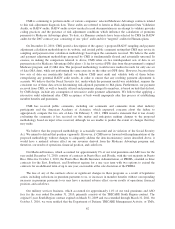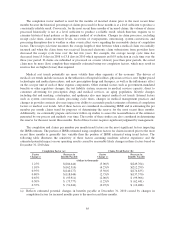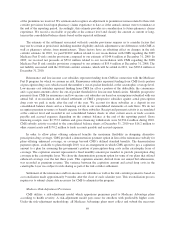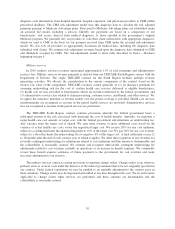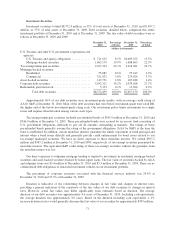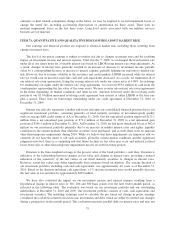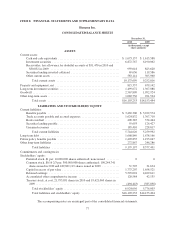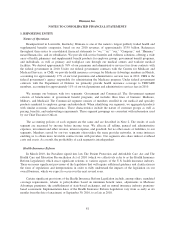Humana 2010 Annual Report Download - page 82
Download and view the complete annual report
Please find page 82 of the 2010 Humana annual report below. You can navigate through the pages in the report by either clicking on the pages listed below, or by using the keyword search tool below to find specific information within the annual report.
Gross unrealized losses and fair values aggregated by investment category and length of time that individual
securities have been in a continuous unrealized loss position were as follows at December 31, 2010:
Less than 12 months 12 months or more Total
Fair
Value
Gross
Unrealized
Losses
Fair
Value
Gross
Unrealized
Losses
Fair
Value
Gross
Unrealized
Losses
(in thousands)
December 31, 2010
U.S. Treasury and other U.S.
government corporations
and agencies:
U.S. Treasury and agency
obligations .......... $ 141,766 $ (615) $ 0 $ 0 $ 141,766 $ (615)
Mortgage-backed
securities ........... 110,358 (1,054) 5,557 (119) 115,915 (1,173)
Tax-exempt municipal
securities ............... 1,168,221 (33,218) 97,809 (10,401) 1,266,030 (43,619)
Mortgage-backed securities:
Residential ............ 0 0 32,671 (2,675) 32,671 (2,675)
Commercial ........... 0 0 2,752 (171) 2,752 (171)
Asset-backed securities ...... 17,069 (42) 283 (2) 17,352 (44)
Corporate debt securities ..... 383,677 (9,572) 31,464 (4,138) 415,141 (13,710)
Total debt
securities ....... $1,821,091 $(44,501) $170,536 $(17,506) $1,991,627 $(62,007)
In April 2009, the Financial Accounting Standards Board, or the FASB, issued new guidance to address
concerns about (1) measuring the fair value of financial instruments when the markets become inactive and
quoted prices may reflect distressed transactions and (2) recording impairment charges on investments in debt
securities. The new guidance highlighted and expanded on the factors that should be considered in estimating fair
value when the volume and level of activity for a financial asset or liability has significantly decreased and
required new disclosures relating to fair value measurement inputs and valuation techniques (including changes
in inputs and valuation techniques). In addition, new guidance regarding recognition and presentation of other-
than-temporary impairments changed (1) the trigger for determining whether an other-than-temporary
impairment exists and (2) the amount of an impairment charge to be recorded in earnings. We adopted the
provisions of the new guidance for the quarter ended June 30, 2009. Refer to Note 4 and Note 5 to the
consolidated financial statements included in Item 8.—Financial Statements and Supplementary Data for
disclosures related to the implementation of the new guidance.
Under the revised other-than-temporary impairment model for debt securities held, we recognize an
impairment loss in income in an amount equal to the full difference between the amortized cost basis and the fair
value when we have the intent to sell the debt security or it is more likely than not we will be required to sell the
debt security before recovery of our amortized cost basis. However, if we do not intend to sell the debt security,
we evaluate the expected cash flows to be received as compared to amortized cost and determine if a credit loss
has occurred. In the event of a credit loss, only the amount of the impairment associated with the credit loss is
recognized currently in income with the remainder of the loss recognized in other comprehensive income.
When we do not intend to sell a security in an unrealized loss position, potential other-than-temporary
impairment is considered using a variety of factors, including the length of time and extent to which the fair
value has been less than cost; adverse conditions specifically related to the industry, geographic area or financial
condition of the issuer or underlying collateral of a security; payment structure of the security; changes in credit
rating of the security by the rating agencies; the volatility of the fair value changes; and changes in fair value of
72


